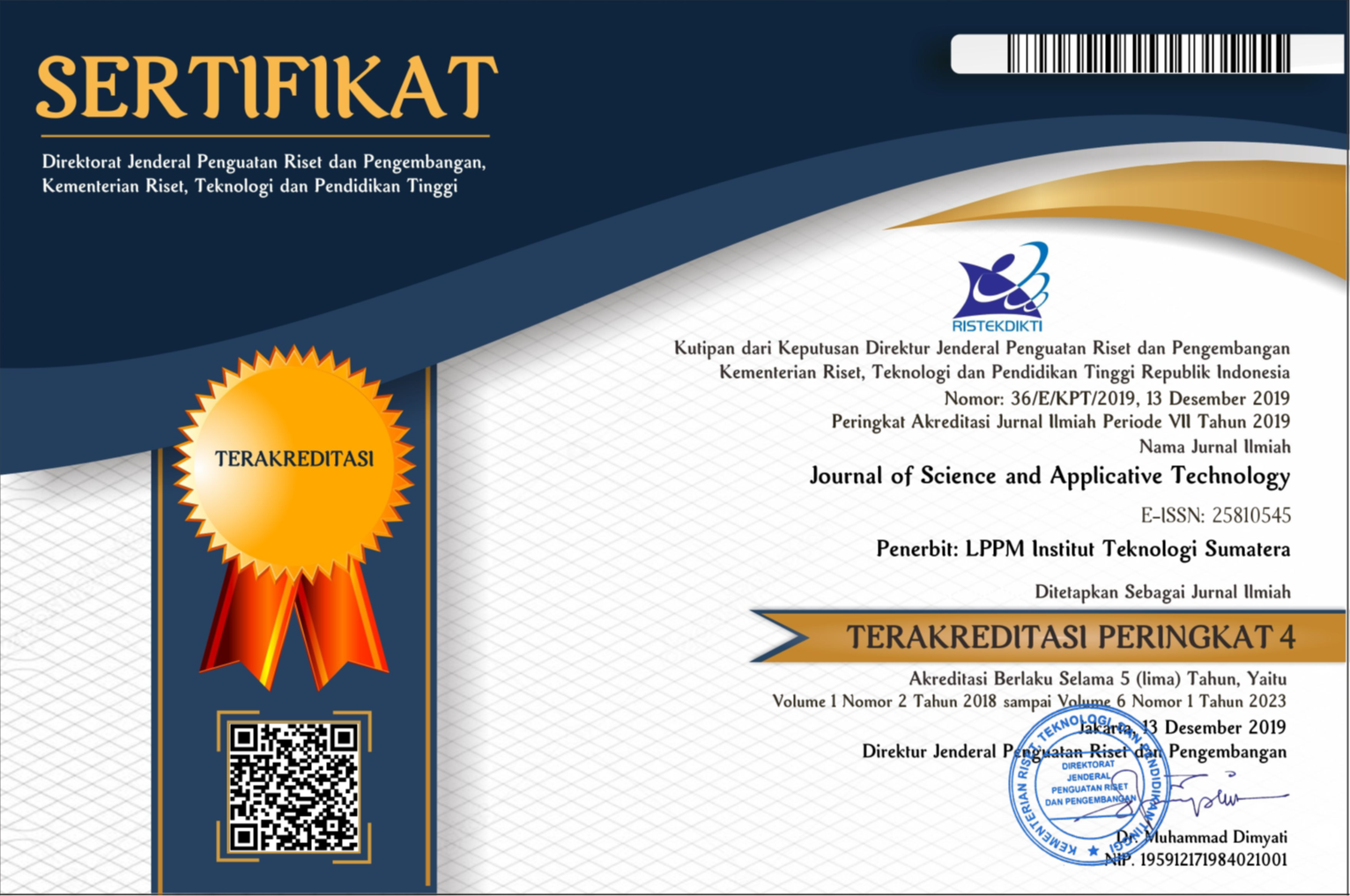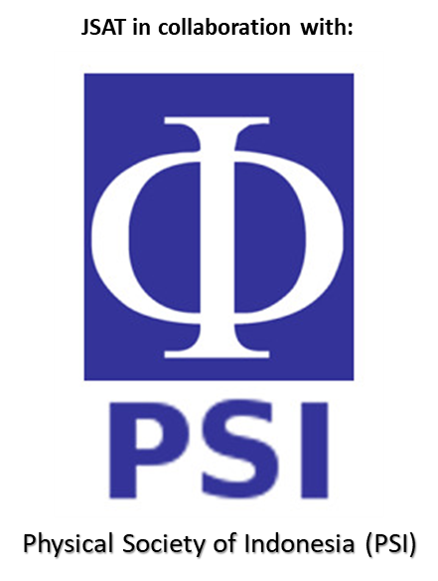Studi Ekstraksi Bijih Emas Asal Pesawaran dengan Metode Pelindian Agitasi dalam Larutan Sianida
Abstract
Research on the extraction of gold ore from Pesawaran, , Lampung, Indonesia, was carried out using the agitation leaching method in cyanide solution. This study aimed to obtain information on the use of conventional cyanidation methods for extracting gold from the Pesawaran gold ore. The ore preparation was carried out in the form of crushing, grinding and sieving to obtain samples with fraction sizes of -60 + 100 mesh, -100 +150 mesh, -150 + 200 mesh and -200 mesh. The ore characterization was performed using XRD, XRF, SEM-EDX, and wet chemical analysis. The XRD analysis showed that the main mineral phases were silica, hematite, aluminium hydroxide and orthoclase. The major constituents of the ore were Si (53,628%), Fe (15,996%), K (19,744%) and Al (8,045%). The Au content was determined by wet chemical analysis and was found to be 9.67 ppm. The experimental results show that the highest percentage of gold extraction of 83.33% was obtained using sodium cyanide at a concentration of 1000 ppm, a percent solids of 40% and a grain size of 200 mesh. Higher gold extraction was not achieved despite the use of a high cyanide concentration was probably because the remaining gold was not properly liberated. The results of SEM-EDX analysis showed that the gold grain size was <20 µm, while the grinding was performed only to a sieve size of -200 mesh (74 µm).
Downloads
References
[2] T. O. Nunan et al., “Improvements in gold ore cyanidation by pre-oxidation with hydrogen peroxide,†Miner. Eng., 2017, doi: 10.1016/j.mineng.2017.01.006.
[3] M. Tanriverdi, H. Mordoǧan, and Ü. Ipekoǧlu, “Leaching of OvacIk gold ore with cyanide, thiourea and thiosulphate,†Miner. Eng., 2005, doi: 10.1016/j.mineng.2004.06.012.
[4] M. E. Wadsworth, X. Zhu, J. S. Thompson, and C. J. Pereira, “Gold dissolution and activation in cyanide solution: Kinetics and mechanism,†Hydrometallurgy, 2000, doi: 10.1016/S0304-386X(00)00084-0.
[5] S. Yu et al., “Ultrasound-assisted cyanide extraction of gold from gold concentrate at low temperature,†Ultrason. Sonochem., 2020, doi: 10.1016/j.ultsonch.2020.105039.
[6] F. Bisceglie, D. Civati, B. Bonati, and F. D. Faraci, “Reduction of potassium cyanide usage in a consolidated industrial process for gold recovery from wastes and scraps,†J. Clean. Prod., 2017, doi: 10.1016/j.jclepro.2016.11.103.
[7] M. A. Mamelkina et al., “Treatment of mining wastewater polluted with cyanide by coagulation processes: A mechanistic study,†Sep. Purif. Technol., 2020, doi: 10.1016/j.seppur.2019.116345.
[8] M. Aazami, G. T. Lapidus, and A. Azadeh, “The effect of solution parameters on the thiosulfate leaching of Zarshouran refractory gold ore,†Int. J. Miner. Process., 2014, doi: 10.1016/j.minpro.2014.08.001.
[9] I. Chandra and M. I. Jeffrey, “An electrochemical study of the effect of additives and electrolyte on the dissolution of gold in thiosulfate solutions,†Hydrometallurgy, 2004, doi: 10.1016/j.hydromet.2003.12.002.
[10] O. Sitando, X. Dai, G. Senanayake, A. N. Nikoloski, and P. Breuer, “A fundamental study of gold leaching in a thiosulfate‑oxygen‑copper system in the presence of activated carbon,†Hydrometallurgy, 2020, doi: 10.1016/j.hydromet.2019.105232.
[11] H. Zhang, C. A. Jeffery, and M. I. Jeffrey, “Ion exchange recovery of gold from iodine-iodide solutions,†Hydrometallurgy, 2012, doi: 10.1016/j.hydromet.2012.05.007.
[12] S. S. Konyratbekova, A. Baikonurova, G. A. Ussoltseva, C. Erust, and A. Akcil, “Thermodynamic and kinetic of iodine-iodide leaching in gold hydrometallurgy,†Trans. Nonferrous Met. Soc. China (English Ed., 2015, doi: 10.1016/S1003-6326(15)63980-2.
[13] K. S. Pak, T. A. Zhang, C. S. Kim, and G. H. Kim, “Research on chlorination leaching of pressure-oxidized refractory gold concentrate,†Hydrometallurgy, 2020, doi: 10.1016/j.hydromet.2020.105325.
[14] F. R. Mufakhir, J. M. Sinaga, S. Oediyani, and W. Astuti, “Pelarutan Emas pada Pelindian Konsentrat Emas Hasil Roasting Menggunakan Reagen Tiosianat,†J. Rekayasa Proses, 2019, doi: 10.22146/jrekpros.41519.
[15] E. A. Oraby and J. J. Eksteen, “The leaching of gold, silver and their alloys in alkaline glycine-peroxide solutions and their adsorption on carbon,†Hydrometallurgy, 2015, doi: 10.1016/j.hydromet.2014.12.015.
[16] J. Marsden, I. House,â€The chemistry of gold extraction†SME. 2006.
[17] F. R. Mufakhir et al., “Characterization of gold ore from Tanggamus mine Lampung Province,†IOP Conf. Ser. Mater. Sci. Eng., vol. 478, no. 1, 2019, doi: 10.1088/1757-899X/478/1/012018.
[18] Chandra, “Studi Pemanfaatan Biopolimer Ekstrak Kayu sebagai Zat Aditif Pada Sianidasi untuk peningkatan recovery pengolahan emas di tambang emas Antam Pongkor†M.S. thesis, Rekayasa Pertambangan, Institut Teknologi Bandung, Bandung, Indonesia, 2013.
[19] S. Aminah, “Studi pengaruh penambahan biopolimer ekstrak kayu terhadap performa sianidasi dan adsorpsi emas pada proses sianidasi carbon in leach (CIL)†M.S. thesis, Rekayasa Pertambangan, Institut Teknologi Bandung, Bandung, Indonesia, 2016.
[20] O. Levenspiel. Chemical Reaction Engineering. Industrial & Engineering Chemistry Research, 1999.
[21] M. I. Jeffrey, P. L. Breuer, and W. L. Choo, “A kinetic study that compares the leaching of gold in the cyanide, thiosulfate, and chloride systems,†Metall. Mater. Trans. B Process Metall. Mater. Process. Sci., 2001, doi: 10.1007/s11663-001-0086-7.
All the content on Journal of Science and Applicative Technology (JSAT) may be used under the terms of the Creative Commons Attribution-NonCommercial 4.0 International License.
You are free to:
- Share - copy and redistribute the material in any medium or format
- Adapt - remix, transform, and build upon the material
Under the following terms:
- Attribution - You must give appropriate credit, provide a link to the license, and indicate if changes were made. You may do so in any reasonable manner, but not in any way that suggests the licensor endorses you or your use.
- NonCommercial - You may not use the material for commercial purposes.
- No additional restrictions - You may not apply legal terms or technological measures that legally restrict others from doing anything the license permits.





















